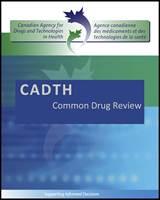Except where otherwise noted, this work is distributed under the terms of a Creative Commons Attribution-NonCommercial-NoDerivatives 4.0 International licence (CC BY-NC-ND), a copy of which is available at http://creativecommons.org/licenses/by-nc-nd/4.0/
NCBI Bookshelf. A service of the National Library of Medicine, National Institutes of Health.
Edoxaban (Lixiana) [Internet]. Ottawa (ON): Canadian Agency for Drugs and Technologies in Health; 2017 Apr.
- AF
atrial fibrillation
- CDR
CADTH Common Drug Review
- CHADS2
congestive heart failure, hypertension, age ≥ 75 years, diabetes mellitus, and prior stroke or transient ischemic attack or thromboembolism
- HS
hemorrhagic stroke
- ICH
intracranial hemorrhage
- IS
ischemic stroke
- MI
myocardial infarction
- NOAC
new oral anticoagulant
- QALY
quality-adjusted life-year
- SEE
systemic embolic event
- TIA
transient ischemic attack
Table 1Summary of the Manufacturer’s Economic Submission
| Drug product | Edoxaban (Lixiana) |
|---|---|
| Study question | What is the cost-effectiveness of edoxaban 60 mg (30 mg dose reduced) compared with warfarin and other NOACs for the prevention of stroke and SEEs in patients with NVAF? |
| Type of economic evaluation | Cost-utility analysis |
| Target population | NVAF patients requiring chronic anticoagulation (i.e., CHADS2 ≥ 2) |
| Treatment | Edoxaban 60 mg (30 mg dose reduced) daily |
| Outcome | QALYs |
| Comparator(s) | Primary analysis Warfarin Rivaroxaban 20 mg daily Secondary analysis Apixaban 5 mg b.i.d. Dabigatran 110 mg b.i.d. Dabigatran 150 mg b.i.d. |
| Perspective | Publicly funded health care system |
| Time horizon | Lifetime (36 years) |
| Results for base case |
|
| Key limitations |
|
| CDR estimate(s) | The model structure and data inputs were considered appropriate; however, apixaban and dabigatran were not considered as comparators. Therefore, CDR performed a sequential comparison of all alternatives (warfarin, edoxaban, and other NOACs) on the basis of the submitted model design, using relative effects from the manufacturer-submitted NMA.
|
AF = atrial fibrillation; b.i.d. = twice daily; CHADS2 = congestive heart failure, hypertension, age = 75 years, diabetes mellitus, and prior stroke or TIA or thromboembolism; CDR = CADTH Common Drug Review; NMA = network meta-analysis; NOAC = new oral anticoagulant; NVAF = nonvalvular atrial fibrillation; QALY = quality adjusted life-year; SEE = systemic embolic event; TIA = transient ischemic attack.
- ABBREVIATIONS - Edoxaban (Lixiana)ABBREVIATIONS - Edoxaban (Lixiana)
- EXECUTIVE SUMMARY - Omalizumab (Xolair)EXECUTIVE SUMMARY - Omalizumab (Xolair)
- ADDITIONAL INFORMATION - Edoxaban (Lixiana)ADDITIONAL INFORMATION - Edoxaban (Lixiana)
- COST COMPARISON - Edoxaban (Lixiana)COST COMPARISON - Edoxaban (Lixiana)
- REVIEWER WORKSHEETS - Edoxaban (Lixiana)REVIEWER WORKSHEETS - Edoxaban (Lixiana)
Your browsing activity is empty.
Activity recording is turned off.
See more...
